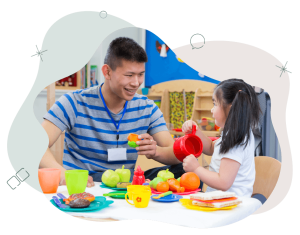34 Observing play: identifying the learning in oral language, imaginary and dramatic play
By observing children’s play teachers are able to notice the inclusion of cultural knowledge, physical skills, cognitive reasoning and an emerging use of contextual language. In the activity below the focus is on observing language and literacy abilities that the children demonstrate in their rich play.

Read, look, listen
The following interaction focuses on a sample of students’ imaginary and dramatic play. Our sample is taken from An Early Years Foundation Stage: Children play at being travel agents video (United Kingdom Department for Education) which presents three school students role playing as travel agents. Watch the video (3.59) below and take note of the many language and literacy abilities that the children demonstrate.
Keep in mind that while this video is narrated to observe particular aspects of the students’ learning, there are many opportunities for assessing the students’ language and literacy. We encourage you to write down any observations you make.
Engage and extend
By rewatching the video with different lenses, you will be able to closely observe the complexity of language and literacy skills that students demonstrate during play. Let’s extend your initial evaluation of the imaginary and dramatic play learning occurring in the travel agents play video above.
We analysed this video sample to look closely at a number of language and literacy abilities that are evident in the children’s play in the travel agency. Move through the interactive below that provides four “Watch and Reflect experiences” in relation to the video. Each experience ends with our analysis or a prompt to capture your observations, which you can view by clicking on the plus (+) icons. Compare our analysis of the children’s language and literacy abilities to your observations.
It’s important to note that the interactive prompt seeks to scaffold this experience and the notes that you made on the interactive are not permanent. Please ensure valuable notes and jottings that you have made are recorded in another notebook or device.
Open text versionClose text version

Watch and Reflect interactive – student imaginary and dramatic play video and analysis
Watch and reflect 1 – speaking and listening
Plus (+) icon message: Read our analysis – speaking and listening
Did you notice two key language elements as you watched the video? Firstly, the questions and answers occurring in the play? Secondly, the ways in which children sound out their name. Speaking and listening are very evident in the interactions within the sample.
For example, the boy playing the role of the customer (James) demonstrates a number of language and literacy abilities. At the beginning of the session, he is able to seek clarification by asking the travel agent (Callum) if the word on the sign says “Open”. This not only shows his ability to ask a question but also demonstrates that James understands features of print. Throughout the interaction, this student, James, is also able to listen to his friends during the play, using appropriate interaction skills to respond to them in this imaginary and dramatic play scenario. James is also able to identify rhyme, letter patterns and sounds in words. This student also uses his knowledge of phonics to sound out the sounds in his name to help the travel agent. You may also have noticed that James understood the days of the week and could negotiate with his peers.
Watch and reflect 2 – interacting and communicating
Plus (+) icon message: Read our analysis – interacting and communicating
Now that you have rewatched this video, what were the interactions and the ways in which children communicate with others that you observed?
For example, throughout this play segment, it is evident that James is able to listen to and respond to the communication of others using interaction skills, including listening, while others speak. Specifically, James is able to:
- listen to, remember and follow simple instructions
- sequence ideas in spoken texts (i.e., the story script being developed by all three students)
- listen for specific things, for example the main idea of a short statement, the details of a story, or to answer a given question
- participate in informal situations, for example play-based experiences which involve the imaginative use of spoken language
- ask and answer questions to clarify understanding.
Watch and reflect 3 – your observations about Callum and Eve
Plus (+) icon message: What were your observations about Callum and Eve? What language and literacies are used by them in this imaginary and dramatic play?
The learner is prompted to add their thoughts about language and literacies by typing into the interactive.
Watch and reflect 4 – your observations about all three students
Plus (+) icon message: Looking at all three students: Can they set the scene, are there distinct characters, are there problems with resolutions, how complex is the sequence of events?
The learner is prompted to add their thoughts by typing into the interactive.

